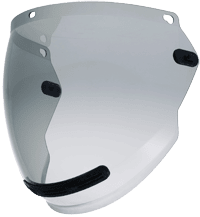High heat face shields are an essential piece of personal protective equipment used to protect the eyes and face from exposure to extreme levels of heat. Polycarbonate is the base material for most high heat face shields, offering numerous benefits such as high impact and temperature resistance. However, since polycarbonate has a heat distortion temperature of 265 °F, it must be combined with other materials to provide adequate protection from high heat conditions such as extreme radiant heat and electrical arc flash.
High Heat Face Shields: Industry Applications & Materials
High heat face shields are used in various working environments to protect workers from extreme heat conditions. Two common hazards that high heat face shields protect against are extreme radiant heat from molten metal, and the potentially devastating blast of an electric arc flash.
Extreme Radiant Heat
Mill and foundry workers, such as those working in steel mills, aluminum mills, glass blowing facilities, etc., are continuously exposed to high levels of radiant heat. Workers in this field melt materials to produce various components, which requires extremely high temperatures. For example, steel melts at 2,000 °F, aluminum melts at 1,200 °F, and titanium melts at 3,000 °F. The radiant heat coming from these molten materials can seriously burn the face or even kill the workers, making it critical to wear protective face shields.
In addition to the radiant heat, face shields also protect the wearer from infrared heat and light present in molten material environments. Infrared heat and light can’t be felt or seen, but without adequate protection, it can essentially “cook” a worker’s eyeballs.
Radiant Heat Face Shield Materials
As previously mentioned, polycarbonate is the base material for all face shields. However, on its own, polycarbonate will begin to warp when exposed to temperatures higher than 265 °F. To ensure our face shields hold up in extreme radiant heat environments, Paulson Manufacturing adds protective materials such as:
- Gold coatings. Gold coatings are designed to optimize visible light transmittance (VLT) while also blocking extreme radiant heat to protect wearers. For our gold heat shields, we apply a gold coating with 99.99% gold particles on an 0.060’’ thick injection-molded polycarbonate base. Most often, the polycarbonate base is clear, but it is also available in green as well as various welding shades to meet the needs of different environments. To protect the actual gold coating, we also apply a silicone-based protective hard coating.
- Aluminized film. Aluminized film heat face shields offer an economical alternative to gold-coated shields. Rather than an injection-molded polycarbonate base, these are made using 0.040’’ thick clear polycarbonate sheets which are die-cut to size. The aluminized film is then laminated onto the flat polycarbonate sheet. Although this option is less durable and will have to be replaced more frequently, it can still block up to 2,000 °F of radiant heat at half the price of gold shields.
Arc Flash
The industrial electrical industry can pose serious risks of arc flash exposure to workers. An electrical arc flash is essentially a “short circuit” through the air, caused by low-impedance connections between the air and the ground or a particular voltage phase within the electrical system. With enough energy, these arcs can continue to grow, rising in temperature until the host system evaporates, melts, or trips.
Compared to radiant heat applications where the worker is exposed to high heat conditions for extended periods, an arc flash is instantaneous and can generate temperatures up to 35,000° F, which is four times hotter than the surface of the sun. Arc-rated face shields can protect electrical workers from the effects of an arc flash, including extreme heat, electrical burns, nerve and vision damage, and more. These shields must meet NFPA 70E electrical safety standards, which outline crucial guidelines for job-site dangers and high-risk electrical environments, such as those exposed to an arc flash.
Arc-Rated Face Shield Materials
Because the conditions of an arc flash are much different than the radiant heat found in a molten metal facility, electrical workers require a different type of protection. Similar to heat reflective face shields, our arc-rated shields have an injection-molded polycarbonate base. However, rather than gold coatings or aluminized films, they feature a proprietary nanoparticle formulation designed to absorb the black body radiation from an arc flash. We compound a nanoparticle blend into the polycarbonate, which is then injection molded to produce face shields with the nanoparticles infused into the polycarbonate resin.
The nanoparticles absorb the energy from the arc flash, which creates a black carbon layer on the shield. This carbon layer is what protects the worker from being burned. Our arc-rated face shields also include anti-fog coatings on the inside as well as hard coatings on the outside to protect against abrasion and assist in arc energy absorption.
Source Your High Heat Face Shields From Paulson Manufacturing
Workers exposed to extreme radiant heat and arc flash hazards require high-performance, quality heat-resistant face shields to protect against burns and other injuries. At Paulson Manufacturing, we are a world leader in safety protective gear, including radiant heat and arc-rated face shields. Using quality materials and coatings, we deliver high heat face shields that not only provide adequate protection but also comply with strict industry standards, including ANSI Z87.1 for face and eye protection.
For more information about our heat face shields or other PPE solutions, contact us or request a quote today.



